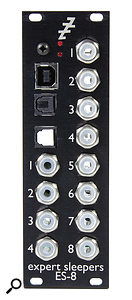Imagine that you’re using a computer-based DAW alongside a modular analogue synth and that you want them to talk to each other. In years past, you would have required a computer/MIDI interface followed by a 5-pin MIDI/CV converter of some description. More recently, you might also have added a CV/MIDI converter to go in the other direction. But today you want to use a single cable to transmit and receive any analogue signals — audio, CVs and timing signals — without differentiating between them, and without any external boxes in the way.
 It sounds like a tall order, but the ES-8 is one of a new generation of Eurorack interfaces that allows you to do this. It provides four analogue inputs, eight ±10V analogue outputs, an eight-in/eight-out ADAT interface, and a USB type B socket for talking to the Mac or iOS device itself. (PC support is not currently available, but is apparently on its way.) Behind the scenes, it also offers headers for an ES-5 Expander, which has further expansion sockets for yet more Expert Sleepers modules, and an ES-6 CV/Lightpipe Interface which, again, can be further expanded with additional modules. If this all sounds a bit esoteric, I’m not surprised; these are products designed for people who enjoy making pieces of equipment talk to one another even though nature had decreed that they should forever be strangers.
It sounds like a tall order, but the ES-8 is one of a new generation of Eurorack interfaces that allows you to do this. It provides four analogue inputs, eight ±10V analogue outputs, an eight-in/eight-out ADAT interface, and a USB type B socket for talking to the Mac or iOS device itself. (PC support is not currently available, but is apparently on its way.) Behind the scenes, it also offers headers for an ES-5 Expander, which has further expansion sockets for yet more Expert Sleepers modules, and an ES-6 CV/Lightpipe Interface which, again, can be further expanded with additional modules. If this all sounds a bit esoteric, I’m not surprised; these are products designed for people who enjoy making pieces of equipment talk to one another even though nature had decreed that they should forever be strangers.
I’m not a fan of ADAT interfaces and would never encourage one within my studio, so I decided to concentrate on the analogue ins and outs, all of which are 3.5mm TS sockets, and thus ideal for patching to the other modules residing in my (and your) Eurorack cases. To do so, I mounted the ES-8 in an AJH Synth MiniMod case in place of VCO3. This proved to be straightforward because the mounting holes on the ES-8 are slots, which makes them compatible with both the Doepfer and Analogue Systems mounting standards. The ES-8’s power connecter conforms to the Doepfer standard used by AJH Synth, so that was no problem either. Once mounted, I connected the ES-8’s USB socket to my MacBook Pro, and patched analogue outputs 1, 2 and 3 (which I had decided would carry CVs) to the appropriate CV inputs on the oscillator and filter modules, and outputs 4 and 5 to the Gate inputs on the dual contour generator module. I then decided that inputs 1 and 2, and outputs 7 and 8, would carry audio, and configured them in the Audio Devices page of OS X’s Audio MIDI Setup utility.
Now that everything was set up, it was time to decide how to generate the CVs that I would send to the MiniMod synth. Expert Sleepers state that, as well as being compatible with the company’s own Silent Way CV generation software (reviewed in SOS January 2013) it will work with Max/MSP, Reaktor, CV Toolkit, zMors, and Audulus, amongst others. I decided that I would like to try it with one of the third-party pieces of software, and contacted Spektro Audio, who very kindly supplied a copy of CV Toolkit 2.5.
If you’ve not installed CV generator software nor jumped through the hoops necessary to direct the generated signals to the right destinations, you’ll find that it can take a bit of time to work out exactly what’s happening. Happily, CV Toolkit makes this relatively painless and, once everything is configured, the results can be great fun. Using the combination of the ES-8 and CV Toolkit, I was soon making the MiniMod jump through hoops that would have been thoroughly impractical using external hardware modulators, sequencers, and timers. I was also able to use the modular synth as an advanced processor for audio signals, whether generated ‘live’ or already recorded to the DAW, and whether output directly or re-recorded into the DAW following mangling. Furthermore, with different software running on the Mac, I could have re-recorded any three of the CVs and timing signals presented to the analogue inputs (CV Toolkit is currently being updated to facilitate this), and later used these to control any analogue synths capable of receiving them.
Expert Sleepers now provide a range of hardware interfaces that allow the digital and analogue worlds to interact and, whichever software you choose, the ES-8 offers more than enough interfacing to get you started, while I suspect that an ES-8 plus its various expanders offer more than enough, period. For many players, I feel that it will be perceived primarily as a device that allows you to incorporate low-cost modulation and sequencing software within your analogue modular synths so, while it’s not cheap, I suspect that it will save you an even greater outlay on hardware modules. Then, once you’ve gotten past the initial learning curve, it will open up all sorts of possibilities that would have seemed unlikely in the old days of MIDI/CV converters.
